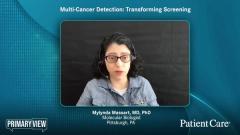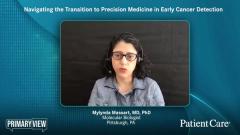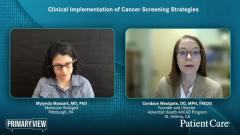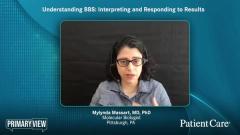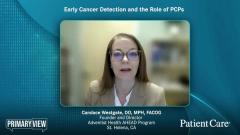
Understanding BBS: Interpreting and Responding to Results
Mylynda Massart, MD, PhD, nuances of blood-based screening (BBS) in early cancer detection and how doctors can respond to various results.
Episodes in this series

Transcript
Candace Westgate, DO, MPH, FACOG:Let’s talk a little bit more about actually interpreting these results. So we know that the majority of our patients that we do test will come back with no cancer signal detected. But when it does come back “cancer signal detected,” there’s certain steps that need to be taken. So in your opinion, what is the potential burden for patients about the false positives? So let’s talk about that first. Then how do you foresee MCEDs contributing to minimizing both the diagnosis and the risk of that for our patients, and the systems and the cost associated with it?
Mylynda Massart, MD, PhD: Great question. So as I mentioned earlier, one of the great things about multi-cancer early detection is that extremely high positive predictive value. And so our number of false positives is going to be pretty low, but it is always a possibility. So when I explain this to my patients, I start out by saying the average risk for cancer above the age of 50 is about 1 in 200 at any given time. And that means that 98% of our tests are going to come back negative and that will be a true negative. And 1 to 2% of our tests are going to come back positive. And so when that test does come back positive, as I mentioned, the positive predictive value is about 40%. So there’s just under a 1-in-2 chance then with a positive test that that patient actually has cancer at that moment in time. That’s almost 50-50. That’s pretty significant. It’s much more significant than a positive mammogram, for example, which is about 1 in 12 to 15 when it comes back in as positive. And so we are absolutely going to respond to that positive screen and start a diagnostic evaluation. So I let everyone know ahead of time, [there is] very little chance that it’s going to come back positive. If it does come back positive it’s about a 50-50 chance that it’s actually a true positive or a 50-50 chance that it could be a false positive and that we’re going to start that diagnostic evaluation. I then explain that there are a couple of reasons why we could undergo a diagnostic evaluation and not find cancer. One of them, the most obvious, is that it really was a false positive, that there isn’t cancer. And there are lots of studies happening right now where we’re trying to understand what are the factors that can increase the likelihood of detecting a false positive. But some of the things that may cause it to look like a false positive but really be a true positive is that we are looking at a technology that is so advanced now that it is actually possible that we could detect cancer before our imaging diagnostics can detect cancer. And so if we get a positive test and we go work it up diagnostically and we don’t find a cancer, I let folks know ahead of time before we even do the screen that it may be that we catch something before I have the ability to find with our diagnostic means, which means we’re not just going to say, “Oh, it was a false positive” and move on. We’re going to actually follow it up, repeat the test in 3 to 6 months, repeat any screening, and watch very closely for the evolution of any types of symptoms. So this is very much based on the biology of cancer. And if all of you remember back from your basic oncology is that it takes a while before tumors become vascularized. And so if a tumor is sitting in a part of the body that is not well vascularized either because it’s just in that type of region, like a skin cancer is not going to show up very quickly in a blood test, or because it’s a new tumor and it hasn’t been really vascularized yet. It’s not going to probably show up in a blood test. So we want to give it some time. We want to pay close attention. We want to keep monitoring it and go from there. I think the second part of your question was how could we use this technology to minimize overdiagnosis? And I think that’s a really promising part of this technology…based on that biology. Cancers that are really slow growing or what we call indolent are less likely to be vascularized and therefore actually less likely to show up in this technology with the cell-free DNA and liquid biopsy. And so there’s some preliminary data showing that this cancer test is more likely to pick up the more aggressive cancers and less likely to pick up those indolent cancers. I’m also really excited to see how we might apply multi-cancer early detection screening in addition to our usual standards of screening and then be able to leverage that to actually guide us like, OK, so that PSA was positive and we see something there that we could potentially biopsy. But is this the prostate cancer that’s going to sit there for 30 years and do nothing? Or is this the prostate cancer that we really need to go aggressively after? And so I’m curious to see in the next 10 years how the technology unfolds as an ability to actually help guide us in avoiding and de-escalating a lot of aggressive management of cancer that maybe doesn’t need to be managed.
Candace Westgate, DO, MPH, FACOG:I’m so glad you brought up the prostate cancer example. You know, we know the mistakes that were made in the prostate cancer screening. And the goal of this is to not to make the same kind of mistakes, but just with the different tests, to actually understand the value of indolent cancer, not overdiagnosing, and the importance of paying attention to that with these kind of multi-cancer early detection tests.
Transcript was AI-generated and edited for clarity.
Newsletter
Enhance your clinical practice with the Patient Care newsletter, offering the latest evidence-based guidelines, diagnostic insights, and treatment strategies for primary care physicians.


